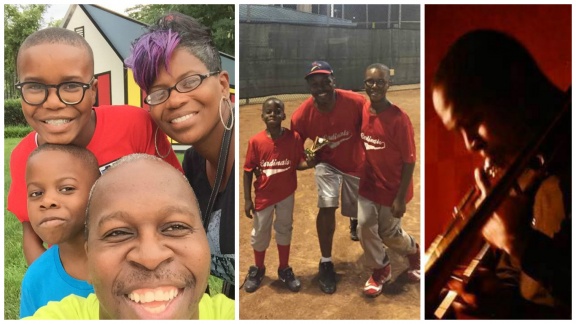Spotlight on Vanderbilt Biostatistics: Jennifer Morse
Next up in the series is one of our wonderful staff biostatisticians, Jennifer Morse, who shares more about her interests in the field and admits her guilty pleasure for Candy Crush Saga! Read on to learn more . . .
What is your research focused on and what have been the major findings so far?
My interests include health policy, survival analysis and reproducible research. I currently have 2 collaborations: The Vanderbilt Center for Kidney Disease and Anesthesiology. In my collaboration with Nephrology, we are interested in looking at what leads to long term kidney disease. We’ve produced several abstracts and papers looking at the effects of factors such as medication use, exercise, and other demographic factors and patient history. In Anesthesiology, I’ve worked on several projects focused on inflammation and oxygen use during surgery and how those factors can have short-term and long-term outcomes that affect patient’s health.
What was your draw to statistics and/or Vanderbilt and what has served as the pathway to your current position?
I was always interested in the intersection of math and medicine. In addition to my statistics degree, I also have a biomedical engineering undergraduate degree and a masters in informatics. Prior to joining this department, I was part of the Department of Anesthesiology, where I assisted in generating and analyzing data for clinical studies. I felt myself reaching the limits of my knowledge and pursued my masters degree at Texas A&M online while working full-time. I love being a biostatistician in this department.
What lessons have you learned from being a biostatistician?
One of the lessons I’ve learned so far is the importance of working with investigators to teach them that statisticians are more than just data analyzers at the end of a project but rather we should be viewed as a resource throughout the project. One of the most important roles of the statistician is to tease out the exact research question the investigator is interested in before rushing in to collect data.
What makes Vanderbilt special in your experiences of collaborating with others? What are your thoughts on controversial statistical topics such as the role of data science in the future, adjusting the p-value for multiple comparison, the choice between Bayesian, likelihood, or frequentists, ethical issues, etc.?
I love the collaborative environment and the opportunities for continuous education. I love hearing about what other collaborators are working on and the exciting research being produced by our teams. There is so much potential for data science to be used to advance medical research and make an impact in a variety of areas. In our department, there are many well-researched and passionate individuals who have strong opinions on controversial topics like those mentioned and I enjoy the rich discussions between those teaching and learning.
Tell us about your family and your life outside of Vanderbilt.
My husband and I are fully engrossed in all things Vanderbilt. We met as undergrads in the marching band. We are not only employees but alumni as well, and fans of all the sports programs. We have two young children, Carter and Ellie, who keep us busy and a puppy named Mango.
We love traveling! We make annual trips to visit our families in Hawaii and Florida and love exploring new places in the US and abroad. Our kids had passports before they were 1 and are already more well-traveled than many adults. Coming up this year, we have family trips planned to Hawaii, Japan, Jamaica and Greece! Always busy, but always having fun!
When in town, one my hobbies is trivia. Every year, I take the online jeopardy test to try and gain a spot on the show but haven’t yet been successful. We’ve also been going to weekly bar trivia for over 10 years now. Lately, you can find our team “Toddlers in a Tavern” at Edley’s or Crow’s Nest around Nashville. My 3 year old recently got to contribute an answer for the first time and was so excited!
Finally, what is something about you that most people at Vanderbilt still don't know about you? (Until now, of course!)
I have a small (not really that small) addiction to the phone game, Candy Crush Saga, and have been playing for over 5 years. I’ve recently passed level 4000 and don’t anticipate stopping until they kill the game.
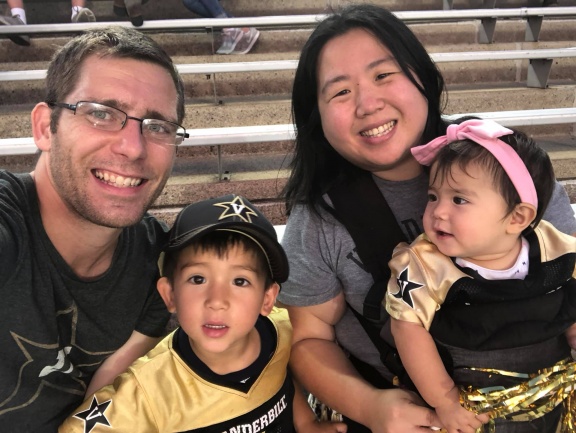
Spotlight on Vanderbilt Biostatistics: Liping Du
This week we are excited to feature one of our faculty members, Liping Du, PhD, who is an Assistant in Biostatistics and supports the Center for Quantitative Sciences. Read on to learn more about her work here at Vanderbilt and her interests outside of our group:
What is the focus of your research and where have your findings been published?
I have worked in several areas of research. When I was a student working with Dr. Robert Tanner in the Chemical Engineering Department of Vanderbilt, we published 11 papers about protein purification using foam fractionation in applied biochemical and biotechnology journals, and in addition we published a book chapter. After graduation, as a biomedical researcher, I investigated the roles of Cytochrome P450 and related lipids in skin biology in Dr. Diane Keeney’s lab and we published 8 related papers in biochemistry, toxicology and pharmacology journals. Then I worked with Dr. Anthony Forster in the field of synthetic biology. We had 3 publications together, and last year a paper based on my work on in vitro synthesis of E. coli translation factor module of a minimal genome was published and 4 plasmids named after my name are in the Genbank now. In the past five years, as a biostatistician, I have collaborated with many investigators and had about 26 collaborative publications in different fields. I also had a statistical method paper in evaluating bioequivalence trials data using the evidential likelihood approach with my advisor Dr. Leena Choi in the Biostatistics Department.
What was your inspiration to pursue a career in statistics?
The hands on experience that I had during my graduate studies in chemical engineering making a novel plasma reactor and a photoelectric device for measuring bubble size distribution in a foam fractionation column was very fulfilling. But I found that I was most interested in the quantitative part-- mathematically modeling the chemical reaction or physical separation process based on theory and confirming the results with the measured data was exciting. I do miss this part of investigating that comes with being in a wet biomedical research lab. Fortunately, the Vanderbilt Biostatistics graduate program was started in 2011 and I joined with one of the earliest cohorts of 8 students. The reputation of Dr. Shyr’s group led me to pursue a position in this group. I am so lucky to be able to work on several interesting projects in the CQS over the past several years.
As a statistician, I love this quote:
“…the statistician must be instinctively and primary a logician and a scientist in the broader sense and only secondarily a user of the specialized statistical techniques…”
What makes Vanderbilt special in your experiences of collaborating with others?
At Vanderbilt, as a statistician, you may collaborate with investigators in different fields. It is so much fun working on many different projects and it is very rewarding. As I learned more about the statistical methods in Frequentist, Bayesian, and Likelihoodist, I often wonder what role statistics (probabilistic relationship) plays in science and in life. Is it providing evidence from the data, and/or guiding our belief, and/or guiding our action using the data? Also, should I consider more the causal relationship (e.g. a DAG and causal model) more in practice than just describing associations with a probabilistic model? These are interesting questions and will keep me pondering.
Tell us about your life outside of Vanderbilt. Do you have a significant other? Children? What about your hobbies?
I am a cook at home; I truly love cooking! I learned from my mom that as a mother I need to feed my family with healthy food and ensure that they have a good appetite at every meal. I have 3 lovely children and they are the joy of my life. As for hobbies, both my husband and I enjoy exercise and outdoor activities. When we have chance, we take the kids out playing sports or out to enjoy nature. I wish I could go hiking more often. I hope we will continue to live a healthy and productive life.
Finally, what is something about you that most people at Vanderbilt still don't know about you? (Until now, of course!)
I have lived around Nashville for over 21 years and it is the place where I have stayed the longest in my life. It is truly becoming my home and I really love this city!
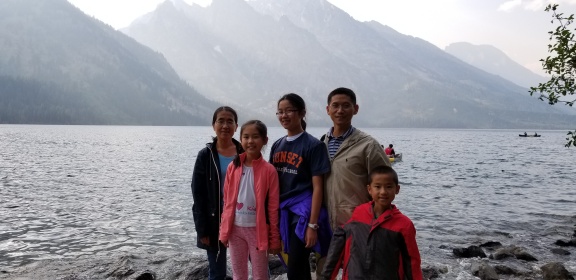
Spotlight on Vanderbilt Biostatistics: Yu Wang
This week we are excited to feature one of our postdoctoral fellows from the Center for Quantitative Sciences within the Department of Biostatistics. Dr. Yu Wang has had experience in both bioinformatics and biostatistics and is involved in some fascinating research. Read on to learn more...
Tell us about your current research focus.
By developing and adopting relevant bioinformatical and biostatistical methods on NGS and clinical data, my work is mainly focused on parsing genetic, transcriptomic, and immunogenetic features associated with response to anti-PD-1 and/or anti-CTLA-4 immunotherapy in patients with malignancies, and developing biomarkers by combining different features to help discriminate patients for choosing more reasonable therapy strategy.
It’s a very challenging and hot topic with significant breakthrough in cancer therapy. I feel excited and lucky to be involved. I set up pipelines for immunogenetic signature evaluation, immune cell composition and neoantigen prediction by integrating WES, RNAseq and SWATH-MS proteomical data. By cooperating with our collaborators, we combine multidimensional data from the somatic mutation and expression profiles, to immunogenetic features in TILs, to depict the key players associated with the response to immune checkpoint blockade therapy and clinical outcomes.
What was your draw to statistics and/or Vanderbilt?
Even though I am working with a lot of biological and clinical data daily, I am still a beginner in biostatistics. I really appreciate the environment provided by our department. I can learn a lot of statistics from our colleagues, courses, workshops, etc. I realize that not only the concepts and methods but also the way of thinking in biostatistics is critical for data science. I cherish the opportunities of being surrounded by the experts, and I hope I can add the cannon into my armory.
Tell us about your publications and research findings.
My most recent first author manuscript was sent out for reviewing and in that manuscript we show that rare mutations in antigen processing machinery are associated with high mutational burden and an enhancement of predicted neoantigens, providing insights into the mechanisms of high mutation burden in some patients. I had previously published about 20 papers in plant science before I joined VUMC. After I transferred to the biomedical research field, I participated as a co-author in several publications in biomedical/clinical journals, like Nature Genetics, NPJ Breast Cancer, JCI Insight, bioRXiv etc.
What makes Vanderbilt special in your experiences of collaborating with others?
It’s actually my favorite part about working in CQS/Biostatistics/VUMC. With Dr. Xu's help, I am able to be focused on a specific and challenging topic with many active collaborators who work in cancer cell biology, cancer immunology and in the clinic at VUMC. They are all immunotherapeutic experts and can provide valuable data and suggestions. I can always count on help from my colleagues in many ways and know who to turn to for help with questions I have pertaining to NGS data analysis, cloud computing, REDCap and many other areas. The atmosphere of collaborating is critical for personal development as a researcher in interdisciplinary fields, like bioinformatics, and for trying to make efforts to study complex diseases.
Tell us about your life outside of Vanderbilt. Do you have a significant other? Children? Pets? What about your hobbies? What are your goals for the future?
Music, cuisine and basketball feed my body and soul. The Spurs with Tim Duncan is my favorite team. I have been married to my wife for eight years. She was my classmate in college and is currently pursuing a MS’s degree in Biostatistics. We really hope to add new members to our home soon; I had a German shepherd when I was in high school and we plan to adopt a puppy next year.
Finally, what is something about you that most people at Vanderbilt still don't know about you? (Until now, of course!)
Well, this is a good opportunity to explain how to pronounce my first name “Yu”. It’s totally fine for me if you say it as ‘/ju:/’, like in “Thank you”. But if you want to know something about Chinese language or just for fun, here are tips. Some of you may know that there are many Chinese characters. Each character has a sound (some have multiple). And for each sound, there are four tones. The “u” here is a vowel which is not exist in English (that is why it’s difficult for native English speakers and it is actually written as “ü”). Here is a link of explaining how to pronounce it. Here is an example on YouTube. My name is the fourth tones. Try it!
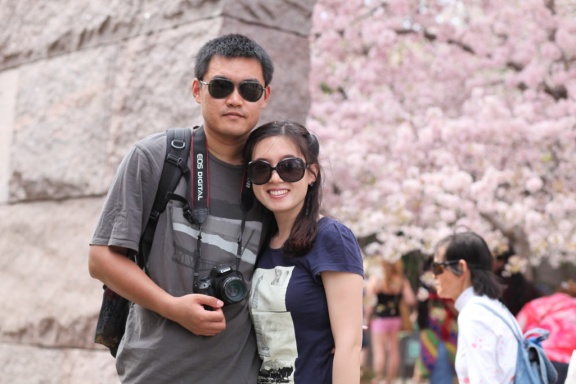
Spotlight on Vanderbilt Biostatistics: Ahra Kim
This week's Spotlight features one of our newer staff biostatisticians, Ahra Kim. Learn how this Southern California native ventured East to Nashville for a great opportunity in research and is now learning to brave the winters, all while providing statistical support to her collaborators here at Vanderbilt.
Tell us about the research you are involved in.
I am involved with three collaborations here at Vanderbilt. Half of my time is spent working on projects with the Caribbean, Central and South America network (CCASAnet) for HIV epidemiology. It consists of HIV clinical sites from seven countries in Latin America, and is also a member of a larger consortium, International Epidemiologic Databases to Evaluate AIDS (IeDEA). In one study, we are comparing outcomes such as mortality, retention in care, and timing of antiretroviral therapy initiation in HIV infected adults with and without tuberculosis. We have recently submitted several abstracts to a conference and are currently working on additional analyses for manuscripts.
My two other collaborations are with the Department of Psychiatry and Center for Biomedical Ethics. For one project in Psychiatry, we are interested in assessing how catatonia and delirium affect survival in critically-ill patients. For Biomedical Ethics, we have been trying to better understand characteristics of patients needing ethical consults for controversial topics like organ donation or treatment decision making, as well as practice patterns of clinicians when it comes to these issues. I am grateful to be working on such a wide range of interesting projects.
What was your draw to statistics and/or Vanderbilt?
I was drawn to statistics in a non-traditional way since I have a social science background. I enjoyed doing research, but many of my classes as an undergraduate involved secondary research and I wanted to do something more hands-on. I was fascinated when I took a course in biostatistics, which was my first exposure to learning R programming. This encouraged me to pursue a master’s degree in biostatistics. Joining the Department at Vanderbilt was an amazing opportunity for me as a new graduate, so I relocated from California.
What lessons have you learned from being a biostatistician?
Though I haven’t been a biostatistician for very long now, I’ve learned that being organized and transparent is key. Sometimes projects pause and resume months or even years later, so it’s helpful to clearly document everything and practice reproducibility to avoid confusion and save time in the long run.
What makes Vanderbilt special in your experiences of collaborating with others?
The collaboration opportunities here have been wonderful. Everybody has been very kind and respectful, and view statisticians as valuable team members. I also appreciate the diverse resources and how there are so many experts in various fields that you can learn from, especially if you encounter a difficult problem in an area you may not be familiar with.
Tell us about your life outside of Vanderbilt. Do you have a significant other? What about your hobbies?
I have been engaged to my fiancé for almost a year now and will be getting married next spring. We both moved here from California. Outside of work, I enjoy a variety of hobbies including hiking, playing tennis, and practicing yoga. I also like to see live music performances, visit cool galleries or exhibits, and occasionally attend sporting events.
Finally, what is something about you that most people at Vanderbilt still don't know about you?
Prior to moving to Nashville, I lived in an inland region of Southern California (Inland Empire) where summer temperatures can reach highs of 116 degrees Fahrenheit. Winters are usually mild with highs in the 60s. Coming to Nashville, I was shocked to see temperatures drop to single digits last winter. Though I’ve been here for a year and half now, I still haven’t acclimated fully to the cold!
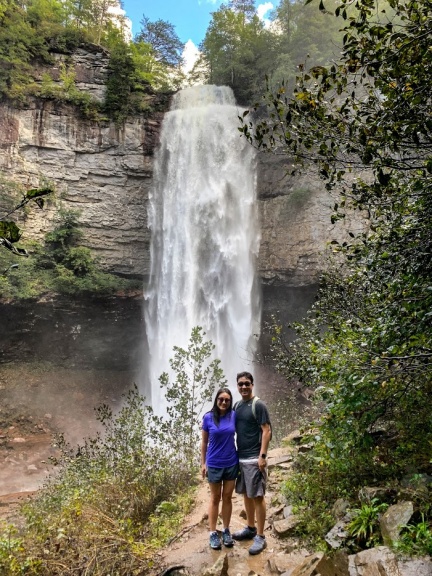
Spotlight on Vanderbilt Biostatistics: Samuel Nwosu
This week's spotlight features one of our amazing staff biostatisticians, Samuel Nwosu. Read on to learn more about his work and contributions to medical research through biostatistics . . .
What is your research focus and what have been the major findings so far in your research?
My main research collaboration has been working with the International Study of Comparative Health Effectiveness with Medical and Invasive Approaches (ISCHEMIA) clinical trial group. This has been a 6 year ongoing NIH grant funded study, with a primary goal of determining whether an invasive (INV) strategy of routine early cardiac catheterization will reduce the incidence of major adverse cardiovascular death as compared to an initial conservative (CON) medical therapy approach. The study spans across 38 countries with over 300 sites enrolling patients. This is a great team to be part of, there are seven principle collaborators and 16 collaborating research institutes, all having vast knowledge and experience in cardiovascular research.
The study is scheduled to be completed towards the end of 2019 and we are currently working to finalize the main manuscripts. In July of this past year, while outlining the methods and procedures of the trial, our study group did publish the ISCHEMIA Design Paper in the American Heart Journal (AHJ) which was a great accomplishment.
Our group is also working on a ancillary ISCHEMIA trial called the Chronic Kidney Disease (CKD) trial. The primary objective of this trial is to determine whether an invasive strategy of cardiac catheterization will reduce the composite endpoint of death or nonfatal myocardial infarction in patients with stable ischemic heart disease and advanced chronic kidney disease. This study is also a multinational trial including 30 countries and over 100 sites.
With ischemia being one of the leading causes in heart disease, its great knowing that this research can change how they diagnose and treat this condition as we move into the future.
What was your draw to statistics and/or Vanderbilt?
It was almost serendipitous how I got into the field of biostatistics. I have somewhat always had an affinity for math and how it relates to everyday life. I graduated with an undergraduate degree in mathematics, uncertain which career field I should pursue with my degree. I researched different fields from accounting to economics, then by chance one of my undergraduate professors asked me if I liked statistics and suggested I look into the field of biostatistics. As I researched the more about biostatistics I saw how I could bridge my background in mathematics with statistics and apply it to the field of health research. Upon finishing my last semester in graduate school, my advisor forwarded me the job opening for a biostatistician II position within Vanderbilt's biostatistics department, I applied and I was able to start my career as a biostatistician.
What makes Vanderbilt special in your experiences of collaborating with others?
What I enjoy about my job is the opportunity to work with so many talented people and the ability to be involved in cutting edge research. I've been able to work on a variety of different collaborations from PTSD research to multinational clinical trials. I like the fact that knowing the research I am involved with can enrich the scientific world and benefit people at the same time. Plus, it is also gratifying that I work in a department that fosters growth and high importance on continuing education. I've been able to grow as a biostatistician due to working in such a great environment.
Tell us about your life outside of Vanderbilt.
I am married to Brionni Nwosu, a professor at the Relay Graduate School of Education. We have two beautiful girls named Kanaya (4 years old) and Kalia (15 months old) who keep our lives filled with joy and excitement. As a family we enjoy spending time playing at the park, visiting the animals at the zoo, or viewing all the sea and water creatures at the aquarium.
Finally, what is something about you that most people at Vanderbilt still don't know about you?
I enjoy the occasional adventurous/extreme activity from time to time- whether it is zip lining, scuba diving, bungee jumping, high speed Go-Karting, or off-roading on dune buggies, I'm game.
Spotlight on Vanderbilt Biostatistics: David Biagi
Next up in the spotlight is one of our Senior Project Managers in the Center for Quantitative Sciences, Mr. David Biagi . Learn more about his role on the team and how he may find favor with a four-legged creature in the coming year . . .
Tell us about your group and role within the CQS IT team.
Our team in the Collaborative Studies Coordinating Center provides database and development support to a wide range of research projects. Our goal is to remove technological barriers for our collaborators. Currently we maintain a wide variety of projects for international research groups, including virtual bio-repositories, clinical trial management systems, and outcome aggregation systems. We hope to continue to enable science-at-scale by helping researchers pool their data, resources, and efforts.
What drew you to Vanderbilt and what has been your experience working in a collaborative environment such as this?
I was attracted to Vanderbilt by the personal recommendation of several colleagues. That trust was not misplaced, as it has been a great place to build a career over the last ten years. I have always felt like my input was valued and appreciated the way I have been enabled to pursue and achieve goals I've suggested in support of the department's efforts.
Tell us about your life outside of Vanderbilt. Do you have a significant other? Children? Pets?
I'm married to my high school sweetheart and we have four daughters ages six months to seven years old. There's a long standing family debate raging over whether or not we should get a dog. I stand alone in opposition and I plan to lose this debate sometime next year.

Spotlight on Vanderbilt Biostatistics: Simon Vandekar
Meet one of our newest faculty members, Dr. Simon Vandekar, an Assistant Professor in the Department of Biostatistics. He is a great addition to our group and it's a pleasure to get to know him.
What are your research interests and what is the focus of your research? What have been the major findings so far?
My statistical research develops inference procedures for high-dimensional data with a particular focus on neuroimaging data. This research has been published in Biostatistics, Neuroimage, and JASA. My collaborative research studies how the brain changes through development and how it is affected in psychiatric disorders. This work has been published in the Journal of Neuroscience, Nature Communications, and Science. My research has relied on family-wise error rate, spatial extent inference, and semiparametric procedures and I would like to begin to develop nonparametric procedures that control the false discovery rate. I am also interested in high-dimensional measures of replicability and the stability of findings across varying preprocessing parameters.
Tell us about any honors you have received, awards you have won or any significant publications you've had.
I was awarded the Saul Winegrad Oustanding Dissertation in my graduate group when I graduated in May 2018. My most recent first author publications were in JASA, Biostatistics, and the Journal of Cerebral Blood Flow and Metabolism.
What was your draw to statistics and what are some of your goals?
I realized I loved statistics after working in a neuroimaging lab after graduation with a BS in psychology. The goal of my research is to develop statistical tools that can be immediately applied to real world problems. I am most interested in semiparametric methods to do this.
Can you share the status of any of your past students? What is your philosophy about teaching or research?
I haven’t mentored any students, but I look forward to the opportunity! I personally learn mathematical or statistical tools best when I use them to solve problems in my research. I think statistical methods should try to make realistic assumptions about the data and that the analysis approach should be determined by particular questions or hypotheses.
What makes Vanderbilt special in your experiences of collaborating with others? What are your thoughts on controversial statistical topics such as adjusting the p-value for multiple comparison, the choice between Bayesian, likelihood, or frequentists, ethical issues, etc.?
The collaborators I’ve worked with here seem extremely focused on the wellbeing of their patients, which makes working with them more rewarding. My work is in multiple comparisons adjustment and I see it as a way for understanding the amount of bias induced by looking at hundreds of thousands of variables, but I don’t think that we should use hard thresholds to decide about the unknown state of the world. Two studies that presents results with and without adjustment are equally valid, but the first provides more evidence against the null hypothesis. I am interested in learning more about semiparametric likelihood and Bayesian methods. I like the probabilistic statements the Bayesian philosophy affords but have an aversion to priors or heavily parametric models because I’m not sure how assumption violations affect the bias and interpretation.
Tell us about your life outside of Vanderbilt. Do you have a significant other? What about your hobbies?
My spouse currently lives in Houston with our two dogs (a dachshund and a basset-lab mix), where she is doing an internship, but she will get to move here soon! I like hiking, camping, running and visiting the many delicious breweries we have in Nashville. I also like foraging for mushrooms.
Finally, what is something about you that most people at Vanderbilt still don't know about you? (Until now, of course!)
My wife and I dabble in extreme sports. My favorite was hang gliding, but we also tried sky diving and go scuba diving not too infrequently.
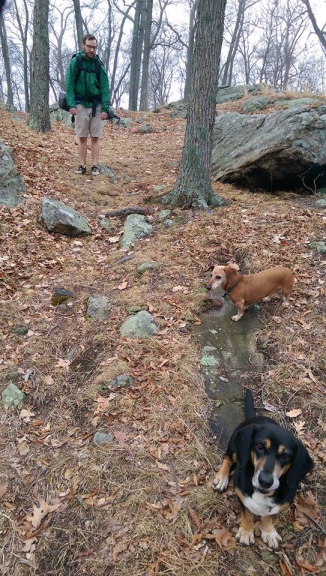
Spotlight on Vanderbilt Biostatistics: Rafe Donahue
Today we are getting to know one of our Department's adjunct professors, Dr. Rafe Donahue. Get the inside scoop about his research and interests!
What is the focus of your research and what have been the major findings so far?
As an adjunct faculty member working in industry, my research doesn't quite line up with the research of my strictly-academic colleagues. The work I do, however, helps patients in a very direct sense, by getting products to market for the benefit of patients and health care providers.
The work that has kept me busy for the last decade or so revolves around a growth factor used in joint fusions, surgeries that eliminate pain by making two bones grow together across a joint that, typically, is damaged by arthritis and thus is painful. This growth factor, we have shown, when properly applied, can be used in place of an autograft, a piece of the patient's own bone, harvested from elsewhere in the body. These autografts can themselves result in problems, hence the value of a product that can be used in their place.
Tell us us about any recent publications you've had.
Our research typically gets published in major medical journals. I was fortunate to get recent publications in Journal of Bone and Joint Surgery, Foot and Ankle Surgery, and Foot and Ankle International.
What was your draw to statistics at Vanderbilt and what have you learned as a statistician?
The Vanderbilt biostats group is a vibrant team of fiercely-bright, top-notch professionals who are not only good statisticians, they are also good people. My relationship with Vanderbilt provides a strong connection to the academic world and provides valuable support to keep the work I do grounded.
Being a statistician has helped me understand how to look at data and see more than just means; it's about understanding variability and distributions.
What is your best advice for aspiring statisticians?
My advice to aspiring statisticians is to commit to getting details right, whether they are statistical or scientific. It's not good enough to say, "Well, that's good enough." Credibility comes with getting the details right. Learn the science; become conversant with your collaborators; don't accept being just a "Would you like fries with that analysis?" kind of statistician. If your collaborators only want someone to compute p-values and sample sizes, get different collaborators.
Good statistics is about good design. Fancy analyses will not save poor design.
Oh, and if your program takes days and days to run, either your analysis is too complex or your coding is not optimal. Or both. (That'll fire up somebody.)
What are your thoughts on controversial statistical topics such as adjusting the p-value for multiple comparison, the choice between Bayesian, likelihood, or frequentists, ethical issues, etc.?
General statistical rant:
We can be our own worst enemies sometimes because of how we teach statistics. Look at the typical class: roll some dice, deal some cards, flip some coins, probability, conditional probability, here's how to compute a mean and a standard deviation and a median, here's how to do a t-test, f-test, chi-square test, regression, Bayes rule, use this R code to compute this, use this R package to compute that, use this SAS program to get data into a format for submission to FDA: everything we teach them is _technical_.
But if you go to seminar, the discussions aren't technical; they are strategic. "How does this impact the bias?" "What does this do to the Type I error rate?" "How does one present these data in the context of treating patients?"
So, people take our courses and they think that we are technical people doing technical work and they think, "I'll just save a ton of time and money and just download a copy of the super-EZ-stat app for Excel and I'll do this all myself!" Or they think, "All I really need is a sample size and I'm too busy to do it myself; I'll just have the statistician compute that sample size for me when I'm in Boca next week."
But, as we statisticians know, it's much more complicated than that. THIS STUFF IS REALLY HARD. And it takes a lifetime to REALLY understand it. There's a great article out there somewhere by Dick DeVeaux and a buddy called something like "Math is Music, Statistics is Literature" It says that you can be a child prodigy in math and music because they are fields that are completely contained within themselves, so you can get folks like Mozart, who composed as a small child, and Guass, who showed, also as a small child, that the sum of the first n integers is (n)(n+1)/2.
But to write really good literature and to do really good statistics, you need to have life experience. You need to understand the human condition and have seen the world in action.
Statistics isn't technical, even though we teach it that way.
Multiplicity/testing thoughts:
Feel free to do multiplicity adjustments but, better yet, show me the whole distribution of p-values (and not just the mean). How do we deal with correlation? How do we deal with the fact that in my lifetime I have look at thousands and thousands of p-values? What's the impact of that?
P-values and inferential statistics only work in a narrow, forward-looking framework: "If I run this experiment and if the null is true and if the data follow the distribution laid out in my plan, then the chance of a false positive outcome is 5%...". Once the trial is run, everything is subject to all sorts of philosophical nuance. We need to be very careful.
There's a big difference between inference from planned experiments and modeling data from EMRs and the like. Bayesian stuff is great for things like that but not so much for planned experiments.
And let's not think that Bayesian methods, as slick and sexy as the math is, are a panacea for all the ills in our modern stats world.
Ethical issues thoughts:
This should go without saying but let's not lie or cheat or stack the deck or mislead. We are nothing as statisticians if we aren't trustworthy. We shouldn't have to teach that but if we do, so be it.
Tell us about your life outside of Vanderbilt. Do you have a significant other? Children?What about your hobbies and future goals?
I have a wife of 27 plus years; we have a little doggie and live south of Nashville in warm and cheerful Nolensville. We are active members of Holy Family Catholic Church in Brentwood.
We have three children. Harry (b 1993) is a lieutenant in the Army stationed (currently!) in Tacoma, WA. Zach (b 1994) is a second-year law student at the University of St. Thomas in Minnesota. Olivia (b 1996) is an artist and care-giver living in Overland Park, KS. They are wonderful sources of Joy and Light.
I have a couple of things that keep me busy outside of work. We have a very large and well-organized Lego collection and we build things and go to conventions and all that. We are part of a local Lego club that hosts an event every November at the public library in Nashville. I typically build replicas of buildings I like or mechanical computing machines.
I also like to make sawdust in my workshop and the occasional furniture that might result from that.
I would love someday to own and run a working bison ranch but I'm thinking that's not going to happen.
Finally, what is something about you that most people at Vanderbilt still don't know about you?Here's something about me that most people don't know: I applied for the astronaut program at NASA several years ago. I actually successfully navigated the application process and my credentials were reviewed. I was, of course, rejected; but I successfully made it through the process. It was a very interesting experience!
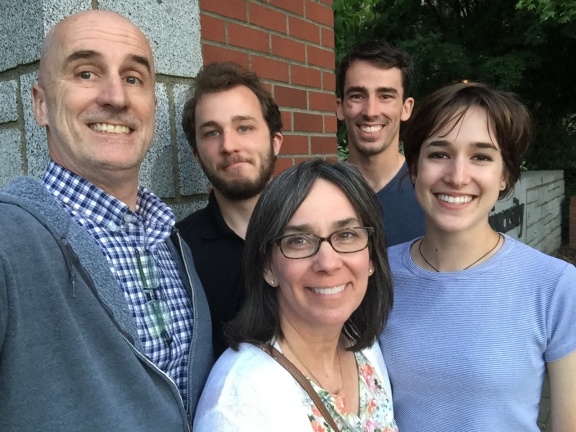
Vanderbilt Department of Biostatistics Takes on the Nashville Sounds
You know it's the middle of summer in Tennessee when you step outside for five minutes and then realize you already feel like going back inside and taking another shower. At that rate, why not stay outside, settle in and spend a few hours supporting your local team and taking in the great game of baseball?
That's exactly what several members of the Vanderbilt Department of Biostatistics did recently, as the Nashville Sounds took on the Round Rock Express, at the First Tennessee Park near the State's capitol on Sunday, June 24th. The Department hosted an outing to gather faculty, staff, students and their loved ones to help commemorate another year of growth and success in the Department.
It was the perfect Southern night to spend outside, sipping on sweet tea, watching the sun fade over the stadium, and taking advantage of a full buffet of ballpark favorites: burgers, slaw, chips and cookies! As we gathered together, it was perfectly evident that this simple outing brought people together. Sometimes we can get so caught up in the day to day hustle and bustle, and just stepping outside the walls of Vanderbilt, enjoying the time to get to see another side of our colleagues, brings a renewed sense of camaraderie among the group.
There's a certain level of hometown pride that sets in as you watch Nashville's Minor League team play in the heat of summer, even though many of us moved here from somewhere else; some from across the country and some from across the world. One thing that remains true is that no matter where you came from, we all have a place to belong here in the Vanderbilt Department of Biostatistics.
Thanks to everyone who was able to make it out to the Nashville Sounds game! We'll look forward to seeing everyone at the next outing!
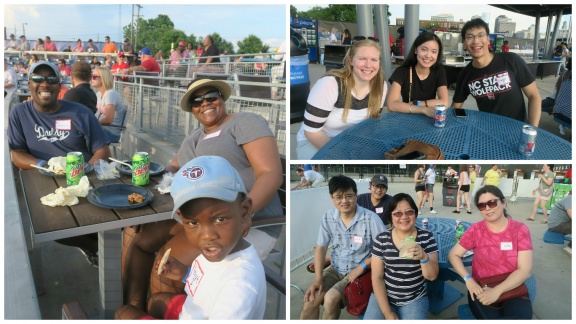
Spotlight on Vanderbilt Biostatistics: Mario Davidson, Ph.D.
To begin our new series, Spotlight on Vanderbilt Biostatistics, we are excited to feature one of our faculty members, Mario Davidson, Ph.D., Assistant Professor in Biostatistics. Read on to learn more about his research and outside interests:
What is your research focused on and what is the potential impact?
My current collaboration is with the School of Medicine. A few years ago the curriculum for medical students changed. Under the previous curriculum, students were in lecture halls a lot during their first few years; with the new curriculum, they are seeing patients right off the bat in their first year.
The curriculum has been embraced by experts and is moving toward competency based education. Students take different courses, have multiple clinical rotations, and are measured in various ways by a variety of clinicians. Students are assessed frequently using milestones, such as behavioral anchors, entrustable professional activities, simulations, and more. The students receive feedback right away and can implement changes using their new knowledge; however, it can be difficult to assess the success and impact of the new curriculum.
Much of the data is taken on a 5-point Likert scale. It is qualitative and quantitative, and there is a great deal of small numbers of observations for many assessments. This lends to messy data and the typical analyses do not tend to resolve our main questions: Is the curriculum working? How can we assess when the students are ready for promotion?
To add, because this curriculum is cutting edge we are the pioneers and we do not have gold standards to measure our data against. However, if all goes well, this research will serve the student better and be useful in helping other curriculums attempting to use our school’s model.
Tell us about a significant publication in your career.
I recently had my first, first-author paper accepted. It took three years to finally get it approved. Admittedly, the peer review process worked. I’m a better writer for it and the paper’s final draft is substantially better than the first. I’m very excited about it!
I teach a statistical collaboration course in our department and decided to discuss the curriculum in this publication. When I began developing the curriculum, I was surprised by how little research was out there on this type of course. Institutes that offer a course like this one are not streamlined by any means. Some places have an internship; others have consulting services; and others allow their students to shadow a mentor. These courses are very different from the typical “hard” skill courses such as regression, theory, categorical data, etc.
I was shocked when I had to piece together the important topics based on the dearth of literature, and perhaps even more shocked when I realized that it was difficult to have a course that addressed all of the important suggested topics. With a little creativity, trial and error, and advice from people like Jeffrey Blume and Matt Shotwell, I developed a curriculum that tackled all of the topics in a feasible manner. Our course focuses on working with clients, asking questions, communicating effectively, being professional, managing one’s time, working ethically, and much more.
If you are interested in learning more about it, click here.
What was your draw to statistics?
My father is the local newspaper’s sports editor and writer and as a kid, he’d take me to the basketball and football games. One of the things I enjoyed most about those experiences was the stats sheets. As a journalist, he’d receive the stats for the game after the halves and final quarters and I enjoyed reading and “analyzing” them.
When I was trying to figure out what I’d major in in college, someone asked me about my interest and told me that actuarial science may appeal to me. I agreed and went to Tennessee State University as a math major. I fell in love with statistics when I had my first class. Unlike my other mathematical courses: Cal I – Cal IV, I did not have to ask, “Why?” It was so obvious that what we were learning was relevant and useful. I suspect somewhere in between my interest in mathematics and my enjoyment at the games I discovered that I wanted to focus on statistics.
What is your best advice for aspiring statisticians?
My best advice for aspiring statisticians is to use school to learn as much as you can and to learn to work with others. As John Donne said, “No man is an island.” When I was in school, I had a peer who worked part time. He’d take classes and go back to work afterward. So while most of us didn’t work or had a TA or an RA position, we had an opportunity to hang around the university all day. We were able to learn from one another and to help each other when we got stuck. He didn’t initially, and struggled because of it. During his second year, he started hanging out more with others in the Department and his understanding dramatically improved.
Another piece of advice I would offer is to constantly work on your communication. We write and talk a lot to researchers, statisticians, students, administrators, staff, etc. We prepare grants, analysis plans, emails, presentations, papers, and reports. One cannot underestimate the ability to communicate. Even more, because we deal with so many people, conflicts arise and difficult situations may take place. When you communicate well, you can stave off a lot of situations before they occur, and stifle many that do occur.
What is your teaching philosophy?
As far as my philosophy, here are the take home points:
Teachers should be somewhat entertaining, teach with real world situations, and provide opportunities for group work and a variety of feedback.
It’s important to recognize that we all learn differently and thus teachers should use various modalities.
I personally believe in constructivism whereby the learner builds their own knowledge. Statistical/mathematical educational research has shown that students learn better when interacting, working in groups. I don’t believe lecturing is bad; it lends itself well to certain exercises and topics. However, I don’t feel it is the most effective way to reach the learner in general. We should try flipped classrooms, multimedia, group work, discovery, labs, problem-based and project based methods, simulations, videos, case-based learning, etc. Juxtaposed with providing assessments and feedback, I believe students learn better with these approaches. Ultimately, I strongly believe in student-centered methods; these methods are interactive and engaging.
What makes Vanderbilt special?
Vanderbilt has a wonderful culture! I’ve been working at Vanderbilt a little over ten years now and I’ve learned a lot about statistics, medicine, and people. We have so many talented faculty, staff, and students and I’ve seen our department grow in wonderful ways. People are doing cutting edge research; getting grants and being published in top journals like NEJM, Biometrics, and Cancer. Not to mention, our graduate program is providing a world class education. It is innovative, teaching Bayesian, Frequentist, and Likelihood approaches and currently is developing a data science program. The amount of detail that goes into developing the curriculum and maintaining high standards of learning are second to none in the School of Medicine.
Tell us about your life outside of Vanderbilt.
Family, music, and baseball are my life and love. I’m coming up on twenty years of marriage on July 4th and my wife and I have two boys. During the Spring and Fall baseball season, you’ll find me coaching both of my kids most days during the week. I’m a big fan of the game. I'm from East St. Louis, IL; which is in the St. Louis area, and both of my sons’ teams are named “Cardinals”-- Go Cardinals!
My other hobby is playing and teaching music. I play the trombone, tuba, baritone, and piano. I play with a big band and a cover band. You can catch me playing, scatting, and improvising around town.
I also give my nephew private lessons on trombone, as well as teach my sons about music theory, singing and playing. During our commute to school each Monday through Thursday I spend the first 10-15 minutes reviewing and by now they know all of their scales and can sing and hear solfege without a piano.
If you’re wondering why I don’t teach them on Friday, it’s because one day they asked, “Dad, do you mind if we don’t do this on Friday?” They’ll thank me later, right? My oldest is playing bassoon and my youngest is working on trumpet.
Finally, what is something fun or quirky that most of your colleagues still don't know about you?
I played in President Clinton’s inaugural parade with Tennessee State University’s Aristocrat of Bands. It was cold and that parade was the first time that I marched with an upright baritone. By the end of the parade my whole chest cavity was sore; that upright baritone is not for the faint of heart.
